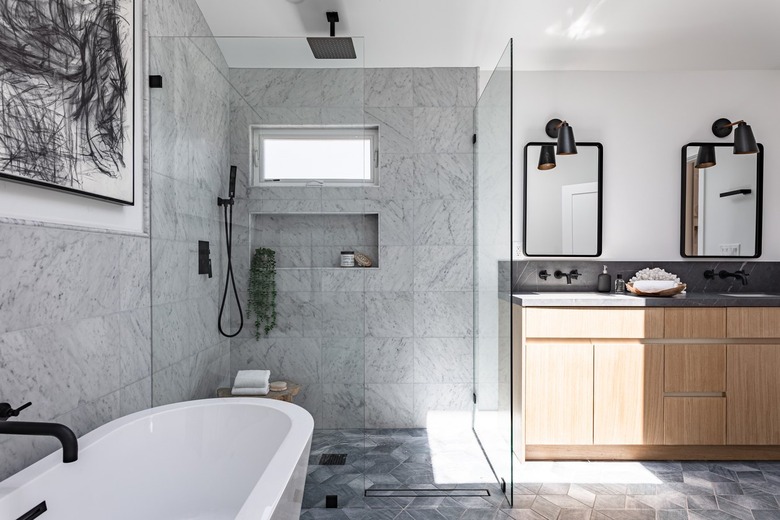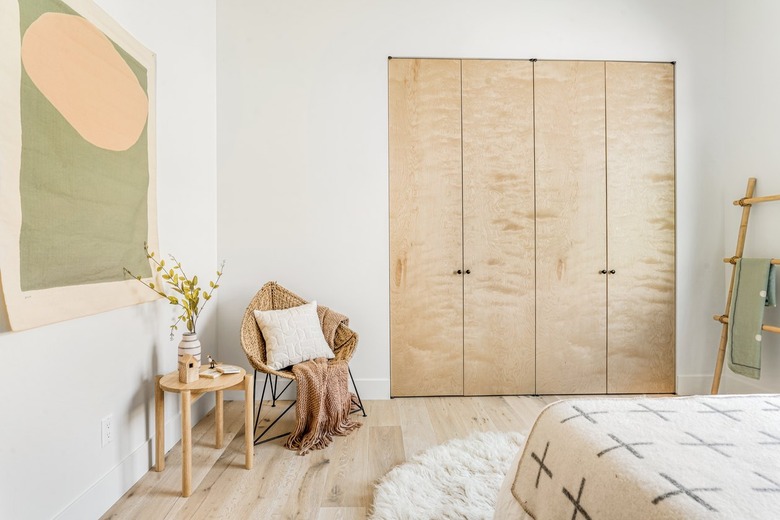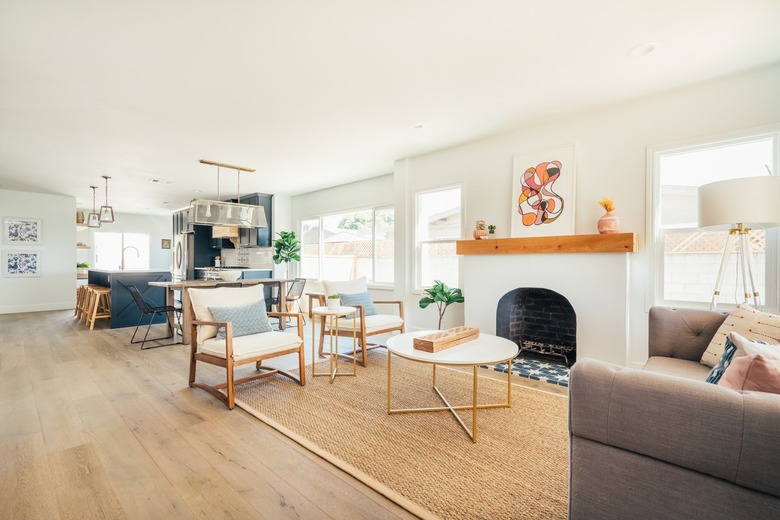What To Know Before You Hire An Interior Designer
We may receive a commission on purchases made from links.
Whether you're short on time or you just don't know how to translate your personal style into a beautifully designed room, an interior designer or decorator is there to assist you with the aesthetics and functionality of a space as you remodel or build a custom home. Though you may feel like an interior designer can only be used on multi-million dollar projects (aka not your home), these home pros can actually save you a lot of money through their designer discounts and potentially even increase the value of your home.
But because your home's design is so personal, it's important to find the right professional for the job. You want someone who knows what they're doing but is still able to take your personal likes and dislikes into account. You'll also want to work with someone who you feel listens to you and is interested in creating a great space for you to live in — not just some good snapshots for their portfolio.
Ready to hire an interior designer for your next big kitchen renovation or primary bedroom suite addition? Here's what you need to know.
What an Interior Designer Does
What an Interior Designer Does
An interior designer is part artist, part technician — they not only help you create a beautiful room using texture and color, but they also inherently understand spaces and how to make them safe and functional. (In other words, they can advise you to put in a kitchen island with a quartz countertop and know that you should have so many inches of clearance for moving around the room.)
Interior design services begin with two important steps. First, they'll need to get to know your space. By viewing, measuring, and examining the room, the interior designer can start to piece together a plan. Their second task is to get to know you. A good designer makes sure you can see your personal style and tastes reflected in the finished product.
Good interior design isn't just pretty but also functional. The right combination of colors, textures, furniture, and other design elements can actually soothe you or help you get energized depending on what you're seeking. Your designer may suggest creative ways to add storage space or have ideas for improving task lighting in the kitchen or office.
After speaking with you about what you need or want from your space and what you like, the designer will come back to your home (or check in virtually, if you hired an online interior design service) with a plan. Sometimes drawn out on paper and sometimes drawn on a computer, the interior designer will show you their plan for your space. If you don't like something in the proposed design, they will make changes for you and tweak it as needed.
Once the plan is finalized, the interior designer can help you find a contractor to do the work if necessary. If not, they'll grab their team of painters and other decorators and get to work on your space. Either way, a good interior designer will stay with you through the design process, overseeing the work and ensuring you get the finished result you're expecting.
Doing Your Homework
Doing Your Homework
Interior designers are usually quite creative and capable of taking any one room in a hundred different design directions. As such, it's good to have some idea of what you want before you talk to a designer. Although you don't need to have a perfect idea of what the room will look like, you should, however, have some idea of what colors you like and which design styles you most gravitate toward (are you more boho or brutalist?).
It's also crucial that you think about how you use your room. An oriental rug may look stunning under your dining room table, but it's not practical if you're feeding a toddler who likes to throw their food on the floor. You may be better served by focusing on a vinyl floor that you can easily clean and storage space for board games if you do Saturday night family time around the table. Understanding how you really use your space — whether it's the living room or a home office — helps a designer marry form and function.
Before you talk to a designer, you also need to know your budget. Frankly, this saves everyone time. Good designers can work wonders with small budgets, so there is no need to feel embarrassed by the number or to try to inflate it. Set up yourself and your designer for success by working together on a realistic budget.
Interior Designer vs. Interior Decorator
Interior Designer vs. Interior Decorator
When looking for design help, it's important to understand the difference between an interior designer and an interior decorator. People often use these two terms interchangeably, but they are technically two different professionals with slightly different skills. An interior decorator can help you make your space more attractive and personal through the use of paint colors, furniture pieces, artwork, and other accessories.
An interior designer does these things too, but designers take things a bit further. While interior decorators focus on how a space looks, an interior designer also examines how it functions. If you want to change the bones of the room or alter the way the space works, you want an interior designer. Interior designers go beyond creativity. Their training helps them understand how to make a space safe and usable in addition to aesthetically pleasing.
Do you want to update your kitchen with new paint, cabinets, and maybe a new countertop? An interior decorator is perfect for the job. Do you want to install a custom kitchen island and move your sink under the kitchen window? Do you feel like your refrigerator and stove top are miles apart? You need an interior designer (or perhaps a kitchen contractor).
Choosing the Right Interior Designer
Choosing the Right Interior Designer
If you've ever watched the popular television show "Trading Spaces," you already know that working with the wrong designer can be disastrous. Fortunately, in the real world, you get to choose the designer with whom you want to work, but it's still an important decision.
Ask any potential interior designers for references and take a look at their portfolio. If you don't respond well to most of the rooms they've done in the past, they're probably not the designer for you. It's also important to ask the designer how they have resolved situations in the past when a client was unhappy. Even a great designer is bound to take a misstep now and then, so they should have an answer to the question.
You'll also want to know how far into the process the designer plans to go with you. A good designer hangs around for the duration of the project. Are they planning on doing that, or will they give you their drawings and leave you on your own? Do you need to shop for the furniture and other design elements, or are they willing to do that with or for you? Ideally, you want someone who isn't going to design and then dash unless that's what you want.
As is true of any contractor you hire to do work in your home, make sure to choose a designer you're comfortable with. This person will be in your home with you on and off for the next few weeks or at least a few days. If they make you feel uneasy, they're probably not a good match. Check with the Better Business Bureau to see if there are complaints against them and be sure to ask for and check references.
It's also important to ask a designer many of the same questions you would ask a general contractor: Do you have liability insurance? At what point in the process is payment due? How do you bill?
Some decorators bill hourly, which works well if you trust them to work fairly independently. If, however, you think you'll call often with changes or questions, you may want to look for someone who charges a flat rate. Some designers charge a percentage of the project's total cost. Make sure you know what you're getting into before the project starts. You could be in for a big surprise if your designer charges by the hour and then puts in a lot of time working behind the scenes.
The Cost of Hiring an Interior Designer
The Cost of Hiring an Interior Designer
Depending on the size and scope of your project, working with an interior designer costs between $2,000 and $5,000, excluding any furnishings purchased for the room makeover. When paying by the hour, expect to pay anywhere from $75 to $500 per hour. Some designers offer flat-rate deals as well, charging a flat amount for rooms of a certain type or size.
Even if your budget is tight, think twice before dismissing the professional design process as too costly. Remember that value isn't just about cost. Good design can increase the value of your home, and a connected designer can save you money. Many designers are privy to special pricing that can save you substantially on furniture and other design elements.
Professional designers also have experience working within many different budgets. Some can stretch a dollar amazingly far and create high-end looks for less. Experienced designers also know where best to put the money for the most impact. Some can take the things you already have and creatively repurpose them to create a brand-new look.
You'll also want to work with a designer if you believe the adage that time is money. An interior designer who works with you from project start to finish will coordinate contractors, deliveries, and vendors so you don't have to. Their experience lets them take care of details about which you wouldn't think and solve problems before you even know you have them.
An experienced designer can also help you avoid costly mistakes. Yes, maybe you do absolutely love that couch, but it might just be way too big for your space. It's better to have an interior designer break this news gently than it is to find yourself standing in front of a gargantuan (and expensive) couch you can't return. When the project is over, most of the people who work with an interior designer feel it was well worth the expense.
Interior Designer Licensing and Certification
Interior Designer Licensing and Certification
Interior decorators aren't required to get licensed and often work without any official credentials. Interior designers, however, must obtain a license to work in more than 20 states. Even if you live in a state with no official licensing requirement, it's recommended that you find a designer who is certified by the well-respected American Society of Interior Designers or a similarly trusted institution.
To get certification through the American Society of Interior Designers, designers must pass an exam administered by the National Council of Interior Design Qualification. Before a designer can sit for the exam, they must accumulate six years of design education, full-time design work, or a combination of the two. The exam expects designers to go beyond the concepts of basic design and decorating, asking test takers to assert knowledge about building codes and identify when it's safe to tear out or move an existing wall. When facing a choice between a certified or uncertified interior designer, always opt for the certified candidate.
References
- Entrepreneur: Starting a Business as a Interior Designer or Decorator
- Forbes: How Hiring An Interior Designer Can Help Save Money On Renovations And Increase The Value Of A Home
- Decorilla: How Much Does an Interior Designer Cost?
- Rocky Mountain College of Art & Design: What is the Difference Between Interior Design and Interior Decorating?
- Decorilla: Hire An Interior Designer: 10 Essential Questions To Ask Them
- Architectural Digest: 7 Questions to Ask an Interior Designer Before You Hire Them


